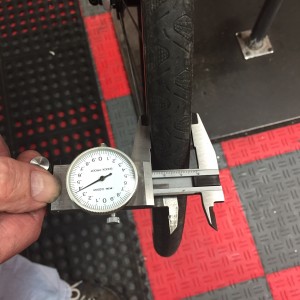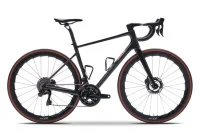How Bicycle Rim Width Effects Tire Width and Contact Patch
How Bicycle Rim Width Effects Tire Width and Contact Patch
By Jim Weaver, Service Manager, Fit Werx, VT
Whether you are riding solo on the backroads of Vermont; are one of the many riding 9W north of New York City on the weekend or are doing a weekly group ride in Concord, Massachusetts, one trend that is universal is that bicycle rim widths are getting wider. Over the past few seasons, many bicycle rim/wheel manufacturers have started producing wider rim widths in order to help create a broader and more consistent tire contact patch to enhance comfort and traction during riding. However, what we noted soon after these wider rims became available is just how much they were changing tire profile. When we installed a 700×23 Continental GP4000S II on a Mavic Ksyrium, it looked quite different than when we installed the same tire on a HED Ardennes +. This made sense as the rim widths were so different, but at the same time it really can throw things for a loop if you are buying tires and are just assuming that the size listed on the tire is what is actually hitting the road. The variety of rim width options now available means that you really need to look at the tire and rim combination together.
To explore how much tire width varied depending on the rim, I first measured the internal width of the following wheels (from narrowest to widest) that I pulled out of inventory from the Fit Werx bike shop near Burlington, Vermont:
- Mavic Ksyrium Elite, 14.7mm
- Corima Aero “S”, 15.2mm
- Zipp 404 Firecrest, 16.4mm
- HED Ardennes SL, 17.9mm
- Enve SES 3.4, 18.2mm
- Boyd Altamont, 18.4mm
- HED Ardennes +, 20.6mm
I measured internal rim width as that is what affects how the tire interacts with the rim while the outside rim width really has more to do with braking surfaces and clearance; the outer thickness of the rim itself has no effect on how the tire sits on the wheel.
I then installed the following tires and inflated them to 100 psi:
- Continental GP4000S II – 23 and 25mm
- Continental GP 4 Seasons – 23, 25 and 28mm
- Michelin Pro 4 Service Course – 23mm
- Michelin Pro 4 Endurance – 25mm
- Vittoria Open Corsa CX – 23 and 25mm.
I will not bore you with the  mind-numbing charts of all of the various measurements for each tire/wheel combination I made; there is no point, as this was not intended to be a comprehensive survey. I was just trying to satisfy curiosity, and trying to get a handle on the general trend. So, on to the most pertinent results when it comes to how rim width effects tire width…
mind-numbing charts of all of the various measurements for each tire/wheel combination I made; there is no point, as this was not intended to be a comprehensive survey. I was just trying to satisfy curiosity, and trying to get a handle on the general trend. So, on to the most pertinent results when it comes to how rim width effects tire width…
The results of all of my tire changing and measuring followed some expected trends. The narrowest combinations were on the narrowest rim, the Mavic Ksyrium Elite. All of the various tires measured very close to their “advertised” width on the Mavic Ksyrium Elite, with the exception of the Continental GP 4 Seasons 28mm tire, which measured only 26.2mm wide on the Mavic Ksyrium Elite. The Continental GP 4000S II 23mm tire measured 23.4 mm; the Michelin Pro 4 Service Course measured 23 mm… However, the consistency of measured tire width to listed width went out the window when I installed the same tires on the wider rims. The HED Ardennes + is a really, really wide rim and the Michelin Pro 4 Service Course listed as a 700×23 measured a full 26mm on the Ardennes+, the Continental GP4000S II (listed as 700×23) measured a whopping 27mm wide (the 700×25 version of this tire measured 28.3 mm), and the 700×28 listed Continental GP 4 Season measured 29 mm. The conclusion? The same tire on the HED Ardennes + may be up to 3.6 mm wider than it is when used on a Mavic Ksyrium! Across the board, the wider the internal width of the tire at the bead, the wider the tire became, often by a lot. The only tire we measured that showed relatively little variance in width across wheels was the Continental Grand Prix 4 Seasons in a 28mm. This may well be an aberration in the construction of that specific tire model or it may be because once a tire is a certain width, it simply doesn’t need to “stretch” across a rim as much, regardless of the rim width. Further investigation is needed to know.
So, what is the takeaway from all this? The functional width of the tire on the bike is not governed solely by the tire’s width, but also the rim width. The differences in tire width between rims are significant. There was up to 3.6mm of width difference with some tires between rims – a 15 percent difference. This increase may be critically significant in terms of what will actually fit on some bikes. We have seen aero frames that will not accept a tire listed at 25mm wide, even mounted on a relatively narrow rim. if a listed 700×23 actually measures 26mm, it will not fit on some frames. Fitting a rim as wide as the HED Ardennes +, or even the Enve, may be too wide for some frames, even with a tire listed at 23mm. The 23mm Continental GP 4000S II tire on the HED wheel measured wider than a Continental Grand Prix 4 Seasons listed as 28mm on the Mavic Ksyrium Elite wheel! So, careful consideration must be given to both the advertised width of the desired tire and the width of the wheel’s rim, to be sure that the wheel/tire combination will indeed fit on the intended bike.
The rim and tire combination is what is important as that determines actual measured tire width. The size listed on the tire sidewall is now relative to the rim. It is likely that the difference in ride perception between different rim widths has more to do with the net effect on actual tire width than anything else. Whether you are in New Jersey, NYC, outside of Boston, in Vermont, or on the other side of the country, Fit Werx can help you understand how things like effective tire width relates to rim width and can help you choose products that are compatible with each other and the rest of your bike.









